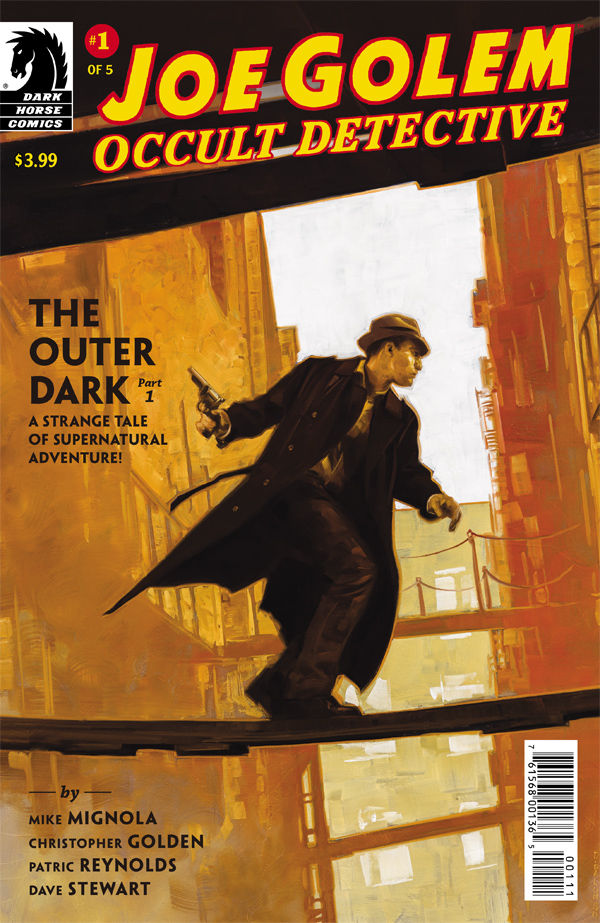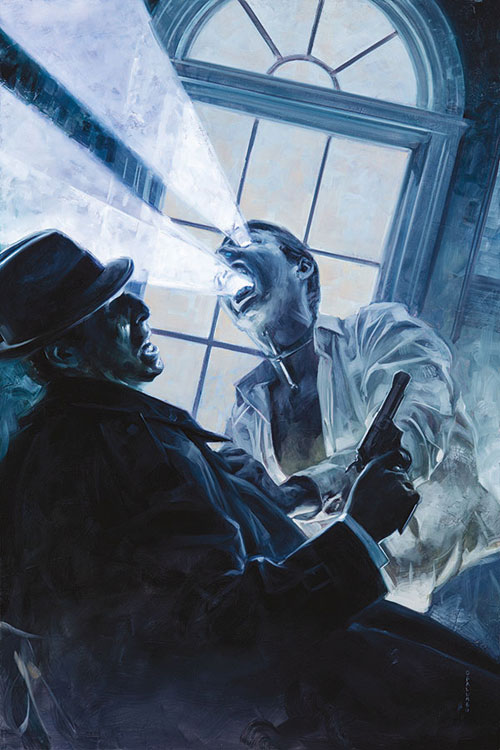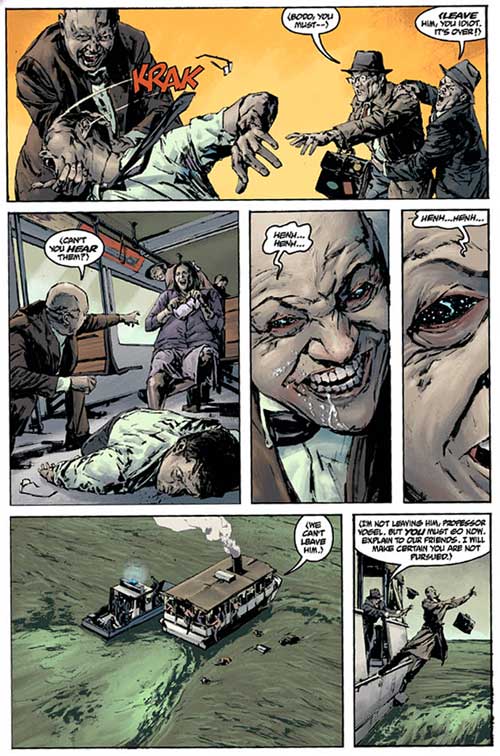Daring The Depths To Draw A Detective
Mar 17, 2017
 |
by Vince Brusio
If you find yourself walking in the rain every day, would you just accept that your lot in life is to walk around with wet feet, or would you do more than continue your search for the perfect umbrella? Writer Patric Reynolds says this is the starting point for Joe Golem. The man of stone and clay does not yield to a traffic circle. He turns off the car, leaves it, and walks across front yards to see what waits for him past the vanishing point. In Joe Golem: Occult Detective — The Outer Dark #1 (MAR170082), we see that it’s the job of artist Patric Reynolds to bring these visuals to light, and in this PREVIEWSworld Exclusive interview he explains how the intricacies of backdrops, bottomless water, and The Drowning City are just as important to Mike Mignola and Christopher Golden’s story as the portrayal of pain in Joe’s quest for enlightenment.
Joe Golem: Occult Detective — The Outer Dark #1 (MAR170082) is in comic shops May 31.
**********
Vince Brusio: So the man of stone and clay has left the Drowning City, and now he’s out to search for a man with superhuman strength. The question is: why? What’s in it for Joe? How is he set on this path, and why should he walk it?
Patric Reynolds: I think that Joe, like a lot of other protagonists in Mike Mignola's stories, is searching for his place in the world, and where he came from. Characters like Joe, Hellboy, and Abe Sapien don't really belong in the world they find themselves in every day. They're outcasts in search of their purpose and trying to come to terms with their own personal mysteries. At various points, they all seem to find themselves involved in battles between good and evil. This conflict seems to awaken these secrets and forces them to come to terms with these shadowy parts of themselves. Joe's journey to self-realization is illuminated a little bit more with every new case that Simon Church hands over to him. His quarries (everything from strange men in "gas suits" to overly ambitious Nazi scientists to the vicious Dr. Cocteau) always seem to know a little bit more about himself than he does, and that leads to start asking Simon Church more and more difficult questions about where he really came from. As the story develops, the paternal relationship between Joe and Church at the center of this world is strained more and more as Joe's search for his identity begins to move more into the foreground of the narrative.
Vince Brusio: You’ve worked on a number of projects for Dark Horse, which include titles that range from Aliens, to Serenity, to Let Me In. Given the occult nature of this story, how does working on Joe Golem compare to these other titles which range from sci-fi to vampire horror? How do you draw this book so that it’s different?
Patric Reynolds: In Joe Golem, there are elements of all those genres — its become a of culmination of everything I've learned and picked up so far in the past eight years working professionally as an artist. There are Victorian-tinged science fiction elements with Simon Church with his occult-powered steampunk organs and the machinery he uses in his observatory, and then there are the horror-soaked flashback scenes from the 15th century where the Golem defends the village from vile, baby-snatching witches. Filter all of that through the genre of a noir detective story and you have a world that is as unique anything I've ever seen or read about. The Drowning City is world that no one has really seen fully rendered before, and I have the challenge to build a world from basically scratch (and some gorgeous spot illustrations from Mike in the original illustrated novel) for the first time in my career. Moreso than any other story that I've drawn, setting of The Drowning City becomes a presence that hopefully lingers and haunts the dark corners of the reader's mind. I wanted to make the reader be aware of the setting, even when it may not be present in a panel.
In aesthetic terms, light plays an important part in everything that I do, and it’s where I start to consider how I'm going to render every panel in every story. I like to use light in a very deliberate way, where it not only defines form but also helps establish a mood and establish the time of day. Even though I'm still trying to employ the same dramatic use of light and dark with Joe Golem, I've trying to approach Joe Golem a little differently by trying to make firmer decisions and focusing more on solid blacks and omitting more elaborate details.
Finally, I always use real people as models so each character is an individual and not a type or a caricature. In this way, every character is unique from any other in each of the stories I draw.
Vince Brusio: What do you use as source material to help you visualize the backgrounds for this book?
Patric Reynolds: The Drowning City is a combination of some pretty diverse elements. After a massive earthquake hit Manhattan in 1925, the water level rose about thirty feet, and technology hasn't really had a chance to advance since then. So I have to not only research what New York looked like in 1925, but also what it would look like if three stories of it were underwater. But there's also the part of the city that's been built on top of it, sort of a makeshift neo-gothic shanty town spread out across the old rooftops, water towers, and fire escapes. I started with trying to cull a lot of reference from Venice Italy, since it’s the only real-life example of a city on top of large pathways of water. But Venice was a city designed and conceived to be built on the water, whereas the Drowning City had to be changed and adapted to be on the water. New York was and is a street-based culture, but the city in the comics had to be converted to a boat and fire escape culture, with various bridges, cables, welded fire escapes stitching together the remains of the buildings. The story in the comic takes place in the 1960s, so I also had to consider the decay and erosion caused by forty years of water eating away at the heart of the city. So I investigated reference from a lot abandoned spaces and other settings afflicted by decay and transformed by time. I wanted to treat the city as a character, and I tried to use those textures of deterioration to enhance the setting's emotional complexion.
Vince Brusio: How do you ultimately settle on the perspective for a particular comic panel? Do Mignola and Golden specifically call out the visual in detail, or do you play with your sketch, and settle on the “final cut” yourself?
Patric Reynolds: Chris's scripts are pretty detailed, but at the same time they leave a lot of room for visual interpretation and composition. For example, sometimes Chris will call for a wide establishing shot that reminds the reader of the uniqueness of city. I've started calling these "hero establishing shots," where the setting dominates the panel. At least a few times in every issue I'll want the reader to experience and move through the setting the same way the other characters do. One way I try to do that is by lowering the horizon line so that the reader's eye level is the same height as the figures in the panel of a particular establishing shot. I'll also make specific composition decisions based on light and time of day, too. In one particular shot, Chris described Joe and Lori talking while walking up a fire escape to a cafe at the top of a building. The shot took place in early morning, so I knew that all that metal work on the fire escape would create some pretty dynamic shadows. So I decided to use the shadows as a design element to frame the figures and direct the viewer's eye to the top of the building where the next panel took place. In another example, I anchored a scene where Lori and Church are having a conversation around the light cast by a desk lamp, using that as a pivot point for the "camera" angles.
In general, Editor Scott Allie will check my layouts against the script to see if the story and all of pertinent details of script are clear. I'll usually have to make some adjustments, but for the most part the final image is pretty close to what I originally interpret from Chris's script.
Vince Brusio: You recently put on your Instagram page that took a whole binder full of original pages from all of the books you’ve drawn. Joe Golem was one of those books you qualified as being one of the “terrific projects over the last 8 years.” What is it about this series’ material that endears itself to you? Is it the characters? Is it the freedom you get because it’s based on an alternate timeline, and that offers you the chance to play with different shades of grey?
Patric Reynolds: This project will always have a place in my heart because I had more freedom to build the world on my own, rather than having to simply recreate specific places and settings that were already established. It’s a lot more intense than just looking up reference for places and settings that have already been built, like Hadley's Hope for Aliens: Fire and Stone or the interior of the Serenity space ship for "Float Out." I was a little more out of my depth and because I didn't have much direct reference, so trying to render the world and its characters was a struggle at first. But those challenges forced me to grow and evolve — everything from my grasp on linear perspective, my reliance on photo reference, to my understanding of human anatomy (among other things) had to be adjusted and reconsidered in some way. I am constantly reminded of David Bowie's advice to artists, which was to "go a little bit out of your depth. And when you don’t feel that your feet are quite touching the bottom, you’re just about in the right place to do something exciting." I'll be forever grateful that "Joe Golem" has set this standard for me.
 |
 |
**********
Vince Brusio writes about comics, and writes comics. He is the long-serving Editor of PREVIEWSworld.com, the creator of PUSSYCATS, and encourages everyone to keep the faith...and keep reading comics.




